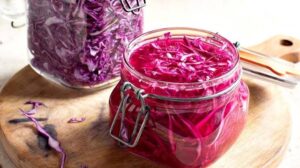When it comes to lacto-fermentation, and you’re wondering how much salt should you add to your ferments, getting the salt ratio right is one of the most important steps in ensuring a safe, tasty, and successful ferment.
The good news? It’s not complicated — all you need is a simple percentage calculation based on the weight or volume of your ingredients.
Calculating Salt
Using percentages makes it easy to adapt recipes for different quantities of vegetables or brine. For best results, always measure in grams or millilitres — the metric system is your friend in fermentation.
Example:
Let’s say you’re fermenting 1 kg of cabbage using 2% salt.
Your calculation would be:
1,000 g x 0.02 (2%) = 20 g of salt
That’s approx 4 teaspoons.
Recommended Salt Percentages for Different Veggies
Salt levels vary depending on what you’re fermenting. Here’s a quick guide:
| Salt % | Best For |
| 2% | Garlic, beetroot, broccoli, carrot, celery, cauliflower, cabbage, green beans, corn, potatoes, radish, tomatoes |
| 3–4% | Cucumbers (pickles), squash, fruits, onions, hot peppers, peppers, Jerusalem artichokes |
| 10% | Olives, umeboshi plums |
Tip: Most vegetable ferments do well with around 2% salt.
A Few Key Things to Remember:
- Less salt (1–2%) = faster fermentation
- More salt (3–10%) = crunchier veg, longer shelf life, less risk of mold
- Under 2% salt? Use a starter culture or calcium chloride to help prevent spoilage
- Never go below 1%, even with a starter culture
Salt Ratios for Dry Salt Brine
When dry salting, you massage salt directly into the shredded vegetables. Use the total weight of your veg to calculate the correct salt quantity.
| Veg Weight | 2% Salt | 3% Salt | 10% Salt |
| 250 g | 5 g (1 tsp) | 7.5 g (1 ½ tsp) | 25 g (1 ½ tbsp) |
| 500 g | 10 g (2 tsp) | 15 g (2 ½ tsp) | 50 g (3 tbsp) |
| 750 g | 15 g (3 tsp) | 22.5 g (4 tsp) | 75 g (4 ½ tbsp) |
| 1 kg | 20 g (4 tsp) | 30 g (5 tsp) | 100 g (6 tbsp) |
Salt Ratios for Liquid Salt Brine
When fermenting with whole or chunky chopped vegetables (like cucumber pickles), you’ll use a water-based salt brine to cover the ingredients completely.
Use the total volume of your container to calculate the salt required.
| Jar Volume | 2% Salt | 3% Salt | 10% Salt |
| 250 ml | 5 g (1 tsp) | 7.5 g (1 ½ tsp) | 25 g (1 ½ tbsp) |
| 500 ml | 10 g (2 tsp) | 15 g (2 ½ tsp) | 50 g (3 tbsp) |
| 750 ml | 15 g (3 tsp) | 22.5 g (4 tsp) | 75 g (4 ½ tbsp) |
| 1 L | 20 g (4 tsp) | 30 g (5 tsp) | 100 g (6 tbsp) |
| 4 L | 80 g (5 tbsp) | 120 g (7 tbsp) | 400 g (23 tbsp) |
Tip: A common household ratio for brining or a salt bath is 2 tablespoons of salt per 1 litre of water.
Final Notes:
- Whether you’re using coarse or fine salt, the difference in weight is minor — measuring by gram is the most reliable.
- If you’re using spoon measurements, consistency matters more than perfection.
- Start with 2% for most veggies, and adjust as you get more confident.
Conclusion
By making these simple changes, you can significantly improve your gut health.
Make sure to grab my “Get Your Gut In Tip Top Shape” eBook for FREE, which includes five easy fermentation recipes you can make at home to help improve your gut health quickly.
Our Fermentation Kits take all the guesswork out of fermenting with our airlock lids, wide mouth mason jars, recipes, pump, glass weights and ongoing support. Grab them on Amazon Australia HERE and Canada HERE.
Ready to go deeper? 4 Week Gut Makeover Program HERE will guide you step by step to creating a healthy gut with gut specific healing foods and supplements to help cleanse, heal and create a healthy gut microbiome in just 4 weeks!
Much raw <3
Amanda



